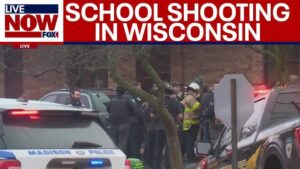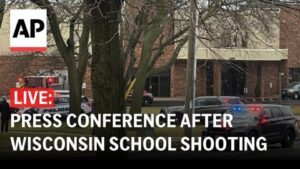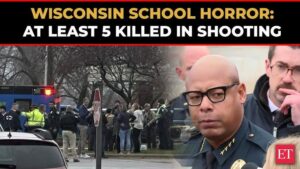Wisconsin School Shooting: A Tragic Reminder of America’s Ongoing Gun Violence Crisis
The serene community of Madison, Wisconsin, was shattered when a deadly shooting occurred at Abundant Life Christian School, leaving families mourning the loss of their loved ones. In an incident that has once again cast a spotlight on America’s unrelenting gun violence, a teacher and a teenage student tragically lost their lives, while several others sustained injuries.
President Joe Biden, in a swift response, condemned the attack, calling it “shocking and unconscionable,” and reiterated his call for Congress to pass commonsense gun safety laws. The incident marks the 84th school shooting in 2024, underscoring an alarming trend that has escalated over recent years.
Immediate and Remote Causes
While the full details are still under investigation, early findings suggest that the shooter, a former student at the school, may have acted due to personal grievances, mental health struggles, or societal isolation. These issues, often recurring themes in school shootings, highlight a mix of psychological, cultural, and systemic failures.
- Immediate Causes:
- The shooter, believed to have been influenced by unresolved conflict, brought a firearm to the campus.
- Reports suggest potential red flags—previous outbursts, social withdrawal, or concerning behavior—that might have gone unnoticed.
- Remote Causes:
- A lack of comprehensive mental health support in schools.
- Easy access to firearms due to lenient gun laws and weak enforcement of regulations.
- Societal factors, including bullying, alienation, or domestic instability.
Sociocultural Aspects and the Shooter’s Background
The sociocultural backdrop of this tragedy cannot be ignored. The shooter, a teenager known for being reserved, reportedly struggled with integration within the school environment. Sociologists argue that issues like bullying, peer rejection, and lack of familial or institutional support can lead young people to extreme actions.
Furthermore, America’s gun culture and the glorification of firearms in media can serve as catalysts. Research shows that shooters are often influenced by previous incidents, with some seeking notoriety in a cycle of tragic replication.
84th School Shooting in 2024: An Alarming Trend
The Wisconsin shooting adds to the harrowing tally of 84 school shootings in 2024, a grim milestone that reveals a steep rise compared to previous years. In 2023, the United States recorded 77 school shootings—numbers that have now been surpassed.
Why the Rise in School Shootings?
Several factors contribute to the escalating violence:
- Gun Accessibility: Despite recurring tragedies, firearms remain easily accessible to individuals, including minors, in many states.
- Mental Health Crisis: Insufficient mental health services fail to address issues before they escalate.
- Societal Disconnection: The erosion of communal bonds and increased reliance on digital interactions exacerbate alienation among youths.
- Copycat Phenomenon: Extensive media coverage of shootings can inspire others seeking recognition or retribution.
A National Response: Calls for Stricter Gun Laws
In his address, President Biden emphasized the urgent need for Congress to pass comprehensive gun control measures, including:
- Universal Background Checks: Ensuring firearms are not accessible to individuals with violent or unstable histories.
- Red Flag Laws: Allowing authorities to temporarily remove firearms from individuals posing a threat.
- Ban on Assault Weapons and High-Capacity Magazines: Limiting access to military-grade firearms often used in mass shootings.
State Superintendent Dr. Jill Underly also expressed her condolences, acknowledging the urgent need for collective action to ensure student safety.
However, these calls for reform face strong resistance from pro-gun lobbyists and certain political factions who cite Second Amendment rights. This divide continues to stall progress on national gun safety legislation.
The Historical and Contemporary Context
School shootings are not a new phenomenon in the United States. Historically, incidents like Columbine (1999) and Sandy Hook (2012) jolted the nation and sparked debates about gun control. Yet, these conversations often lose momentum in the face of political gridlock.
Contemporary factors, however, such as rising mental health crises and the proliferation of social media, have compounded the problem. Analysts also highlight the unique challenge in America: a country with more guns than people, where firearm ownership is deeply ingrained in the national identity.
Casualties and Deterrence: Seeking Solutions
The Wisconsin shooting resulted in two fatalities—a teacher and a teenage student—while several others are receiving medical care. Each casualty adds to the mounting toll of lives lost to gun violence in schools.
While increased school security, mental health programs, and community intervention are essential, experts argue these efforts must be complemented by robust legislative reforms. Without addressing the root causes—gun access, societal disconnect, and mental health—deterrence will remain incomplete.
A Collective Call for Action
The tragedy at Abundant Life Christian School is a sobering reminder of the fragility of life and the urgency of addressing gun violence. Parents, educators, and policymakers alike must collaborate to create safer learning environments for children.
President Biden’s statement reflects the growing frustration among many Americans: “How many more schools must endure this devastation before meaningful change occurs?”
Until gun safety laws, mental health reforms, and cultural shifts converge, the cycle of school shootings risks continuing—leaving behind a legacy of grief, anger, and unanswered questions.
Conclusion
The Wisconsin school shooting has once again highlighted America’s battle with gun violence, systemic failures, and sociocultural challenges. As families grieve their loss, the nation faces an urgent moral and legislative reckoning.
The tragedy serves as a clarion call to prioritize the safety of children, tackle the mental health crisis, and institute long-overdue reforms to curb gun violence. America must now ask itself: How many more lives will it take to bring change?
